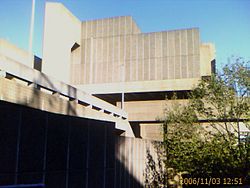Purcell Room
| Purcell Room | |
|
Surrey | |
|---|---|
 Purcell Room auditorium, foyer and high level bridge to The Hayward | |
| Type: | Concert hall |
| Location | |
| Grid reference: | TQ30868031 |
| Location: | 51°30’23"N, 0°6’57"W |
| Town: | Lambeth |
| History | |
| Concert hall | |
| Brutalist | |
| Information | |
| Owned by: | Southbank Centre Ltd |
| Website: | Southbank Centre - Purcell Room |
The Purcell Room is a concert and performance venue which forms part of the Southbank Centre, a major complex of arts and performance venues on the south bank of the River Thames in Lambeth, Surrey. It has 370 seats, and shares a building and some facilities with the Queen Elizabeth Hall and. The Purcell Room is named after the 17th century composer, Henry Purcell.
The Purcell Room hosts a wide range of chamber music, jazz, mime and poetry recitals. Access is through the same foyer as for the Queen Elizabeth Hall and it is most easily reached from the upper riverside terrace of the Royal Festival Hall.
In the context of the Southbank Centre, this is the smallest of a set of three venues, the other two being the Royal Festival Hall, a large symphony hall, and the Queen Elizabeth Hall, which is used for orchestral, chamber and contemporary amplified music.
The Purcell Room was built at the same time as the Queen Elizabeth Hall, with which it shares a common foyer building and architectural features as an example of uncompromising Brutalist architecture. Externally, it is ugly with no concession to decoration: the focus of the building is its interior space. From outside, even its position within Southbank Centre is not easy to discern. The Queen Elizabeth Hall and the Purcell Room were designed, with The Hayward, as additions to the Southbank Centre arts complex by Hubert Bennett, the municipal architect, with Jack Whittle, F.G West and Geoffrey Horsefall.
Architecture
The Purcell Room stands between the Queen Elizabeth Hall auditorium and The Hayward, aligned parallel to Waterloo Bridge, with the stage backing on to the side of the Hall auditorium (the north-west end). The auditorium is cantilevered out over the centre access road and its rear façade faces the entrance to The Hayward. The auditorium is reported to be fitted with a Helmholtz resonator to allow its acoustic properties to be modified.
The access link from the foyer building is through a massive sculpted concrete casing, visible from outside the entrance to The Hayward, near the overhead bridge. The artists' foyer is between the Purcell Room and Queen Elizabeth Hall auditoriums at ground level.
The treatment of the ventilation services is an early example of the external treatment of such equipment. This idea later reached a peak in the Centre Georges Pompidou in Paris and Lloyd's building in London in the 1970s and 80s respectively.
The roof of the building, which is supported independently of the auditorium, holds the plant room for both the Queen Elizabeth Hall and the Purcell Room. The plant room's three massive vents are housed high above the walkway near the entrance to the Hayward and also towards the Waterloo Bridge side of the north corner of the roof. Large concrete ducts lead from the plant room: vertically to the foyer building below by way of the mysterious concrete tower, and horizontally to the QEH auditorium.
Outside links
- Southbank Centre
- LondonDance website (Dance listings and venues)
- The Stage website (Listings information)
- Explore-london.co.uk website (Photographs, including parts of Purcell Room building)
- https://www.flickr.com/groups/southbankcentre/ (A Flickr group dedicated to pictures of the Southbank Centre)
References
- Arup Journal: South Bank Arts Centre; Architects: H. Bennett, Greater London Council chief architect 1967 July, p. 20-31
- Architectural Review: South Bank Arts Centre, London borough of Lambeth; Architects: H. Bennett, architect to the Greater London Council vol. 144, no. 857, 1968 July, p. 14-30
- Official Architecture & Planning: South Bank Cultural Centre, London borough of Lambeth; Architect: H. Bennett, chief architect of the Greater London Council
1969 Aug., p. 918-923